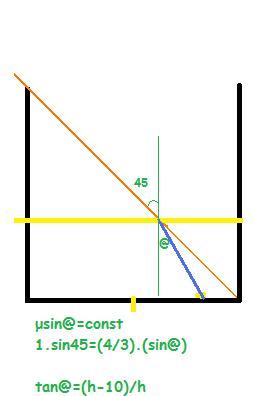hey...anyone can help me out from these questions..pllzzz
Q1. A cylindrical vessel, whose diameter and height both are equal to 30 cm, is placed on horizontal surface and a small particle P is placed in it at a distance of 5 cm from the centre. An eye is placed at a position such that the edge of the bottom is just visible. The particle P is in the plane of drawing. Upto what minimum height should water be poured in the vessel to make the particle P visible?
Q2. An object is placed 20 cm in front of a block of glass 10cm thick and its farther surface is silvered. The image is formed 23.2cm behind the silvered face. Find the refractive index of the glass.
Q3. In a river 2 m deep, a water level measuring post embedded itno the river stands vertically with 1 m of it above the water surface. If the angle of inclination of the sun above the horizon is 30°, calculate the length of the post on the bottom of the river (refractiv index of water = 4/3)
Q4. how long will light take in travelling a distance of 500 metre in water? given that refractiv index for water is 4/3 and the velocity of light in vacuum is 3 x 10(to the power 10) cm/sec. Also calculate equivalent path.
